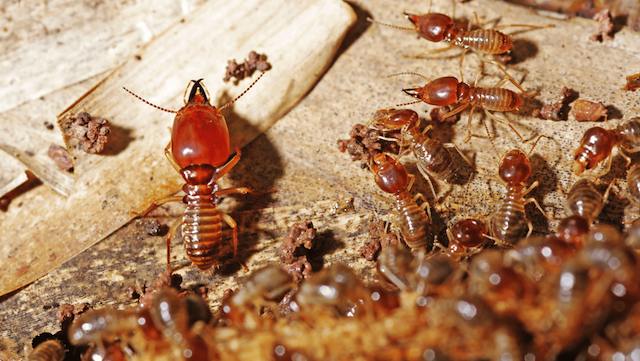
Termites, also known as white ants, are a common and significant threat to homes and buildings. Their ability to cause extensive damage before being detected makes early identification crucial. These pests feed on cellulose, which is found in wood and other materials, and can undermine the structural integrity of your property. This comprehensive guide will help you understand how to identify termites, recognise their behaviour, and take effective measures to get rid of them.
Recognising the Signs of Termite Infestation
Effective termite control begins with early detection. Here are some common signs that you might have a termite infestation in your Singaporean home:
Mud Tubes
Termites, particularly subterranean species, build mud tubes to travel from their colonies to their food sources while staying protected from predators and environmental conditions. These tubes look like pencil-sized tunnels made of mud and are often found along foundation walls, support beams, or inside wall voids.
Hollow Sounding Wood
If you tap on wooden surfaces and hear a hollow sound, it could indicate termite activity. Termites feed on wood from the inside out, leaving a thin shell that can make the wood sound hollow when tapped. This is a common sign of infestation in wooden structures.
Swarmers
Swarmers are winged adult termites that leave their colonies to mate and establish new colonies. These flying insects can often be seen around lights or windows. They resemble ants but have straight, beaded antennae and two pairs of equal-sized wings.
Frass
Frass, or termite droppings, look like small pellets and can be found near the site of infestation. These droppings resemble sawdust and are a clear sign of termite activity within wooden structures.
Uneven or Bubbling Paint
Termites can cause paint to bubble or peel due to the moisture they introduce as they tunnel through wood. If you notice these irregularities in your paint or wallpaper, it might be a sign of underlying termite damage.
Understanding Termite Behaviours

Understanding termite behaviour is essential for effective control. Here’s what you need to know about termites:
Types of Termites
You may encounter several species of termites:
- Subterranean Termites: These termites live underground and create colonies in the soil. They build mud tubes to access wood and can cause significant damage to structures, particularly in humid climates like Singapore.
- Drywood Termites: Drywood termites infest dry wood and do not require contact with the soil. They can cause damage within the wood itself and are commonly found in wooden furniture and structural timber.
- Dampwood Termites: Although less common, dampwood termites thrive in moist, decaying wood. They can still be a problem if conditions in your home are conducive to their presence.
Colony Structure
Termite colonies have a complex social structure with a queen, king, soldiers, and workers. The queen is responsible for laying eggs, while workers perform tasks like feeding the colony and building tunnels. Soldiers protect the colony from threats, including humans and other pests.
Methods for Termite Control

Once you’ve identified a termite infestation, swift action is essential to control and eliminate the pests. Here are some effective methods suitable for most homes:
Professional Pest Control Services
Engaging a professional pest control service is often the most effective way to manage a termite infestation. Pest control companies offer several treatment options, including:
- Liquid Termiticides: These are applied around the foundation to create a barrier that repels or kills termites. They are effective in preventing termites from entering the home.
- Baiting Systems: Bait stations are placed around the property to attract termites. The bait contains substances that disrupt the termites’ growth or reproduction, eventually eliminating the colony.
- Fumigation: For severe infestations, fumigation might be necessary. This involves covering the structure with a tent and introducing a gas that penetrates all areas to kill termites.
DIY Termite Control Methods
For minor infestations or as supplementary measures, you can consider DIY methods such as:
- Boric Acid: This natural insecticide can be applied to affected areas. It dehydrates termites and disrupts their digestive systems.
- Orange Oil: Containing d-limonene, orange oil can kill termites on contact and is typically used for localized infestations.
- Nematodes: Beneficial nematodes are microscopic worms that can be introduced to the soil. They prey on termites and help reduce their population.
Preventive Measures

To prevent future infestations in your home, consider these tips:
- Reduce Moisture: Termites are attracted to moisture. Fix leaks, ensure proper drainage, and use dehumidifiers in areas prone to dampness to make your home less inviting to termites.
- Seal Entry Points: Seal cracks or crevices in your foundation, walls, and around pipes to prevent termites from entering your home.
- Regular Inspections: Schedule regular inspections by pest control professionals to detect any signs of infestation early.
Conclusion
Identifying and addressing termite infestations requires vigilance and prompt action. By recognising the signs of termites, understanding their behaviour, and employing effective control methods, you can protect your home from these destructive pests. Whether you choose professional pest control services or DIY solutions, acting quickly and combining methods will help safeguard your property and maintain its structural integrity. For the best results, consult with experts to tailor a solution to your specific situation.
